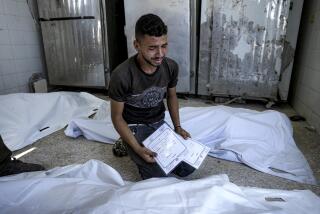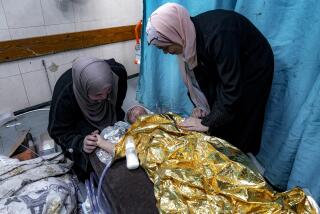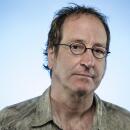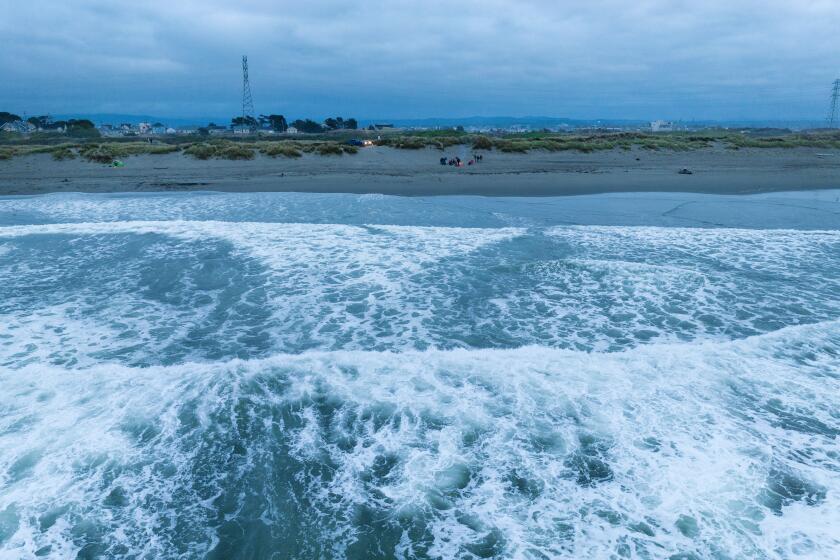Pakistani Quake Orphans Endure an Unstable World
- Share via
ISLAMABAD, Pakistan — She is a girl without identity, whisked here by helicopter from the earthquake zone, one of the devastating temblor’s anonymous -- and most vulnerable -- victims.
The teenager, her hair cut short for head surgery, cries uncontrollably and cannot remember her own name or that of her village. Hospital workers call her Aisha.
“She’s alone in the world. She doesn’t recognize anybody,” said Dr. Robina Quiesha of the Pakistan Institute of Medical Sciences. “I really don’t know what will become of her.”
A magnitude 7.6 earthquake rocked this region Oct. 8. The girl probably is one of thousands of orphans whose families died in the catastrophe or have disappeared.
In Pakistan’s close-knit family structure, children who lose their parents would typically be cared for by uncles, aunts or other relatives. But the wide damage inflicted by the earthquake, which devastated entire mountain villages, made it probable that many youngsters have been left with no family at all.
Despite surviving one disaster, such children must be protected from another ominous fate: falling into the hands of ruthless human traffickers. The government recently has reported the selling of children in hard-hit cities such as Balakot and Muzaffarabad in Pakistani-controlled Kashmir.
Alarmed by the looming threat, hospitals here have placed armed guards outside children’s wards. The government also banned all adoptions after being besieged by people offering to take in homeless children. Administrators at hospitals, refugee camps and emergency shelters will not release any child until kinship has been verified, officials insist.
“Everyone’s overwhelmed with this one. It’s just unexpectedly bad,” said Serap Maktav, the regional child protection advisor for UNICEF.
The earthquake has brought a special focus to the problem, which is complicated by Islamic strictures. The practice of selling vulnerable children into slavery is part of Pakistan’s history.
The U.S. State Department has labeled Pakistan “a source, transit, and destination country for trafficked persons.” International welfare agencies estimate that nearly 100,000 people are trafficked in Pakistan each year. Children are used as laborers, in the sex industry and even exported to the Middle East to become unwilling camel jockeys.
New “anti-trafficking” teams have been instructed to scour refugee camps and shelters to create a database of orphans and unaccompanied women, the government said.
Interpol, the international police agency, has also offered to develop an ID system for orphans. The agency has established laboratories at two Islamabad hospitals where DNA can be tested to confirm parentage. “The first priority of the government is to protect the children from exploitation,” said Mohammed Hassan Mangi, director of the government’s child welfare and development commission.
Western-style adoption doesn’t exist in Pakistan and many other Muslim countries. It is regarded as contrary to Islamic law. Benefactors can sponsor an orphan under a system known as kafala, but the child cannot take his or her sponsor’s last name and has no right to inheritance.
This version of a caste system hinders an orphan’s ability to find work, marry and generally mesh with society.
But the future will be better for the earthquake orphans, said Dr. M. Zaheer Abbasi, head of pediatric surgery at the Pakistan Institute of Medical Sciences. They have attracted the interest of officials at the highest levels of the Pakistani government, including, he said, “the wives of several ministers.”
Abbasi displays a directive from the powerful National Security Council defining standards for the care and protection of the children, but it’s still unclear where they will be housed for the long term.
“They will not just be dumped in an orphanage,” Abbasi said. “The government is very moved.”
International aid groups strongly support the government adoption ban. Particularly in the first months after the quake, they say, it is crucial to register and protect the unaccompanied children and make sure they have no remaining extended family. Local orphanages are a last resort in any country, said Rachel Atkinson, spokeswoman for Save the Children in Pakistan.
“Our first preference is always to keep children in their extended family and in their community,” she said. “They’re much safer there than in an institution.”
Rampant fear of abduction and exploitation stem partly from lingering sensitivities over the thousands of Pakistani boys illegally taken to Arab nations to serve as jockeys in the region’s popular camel races.
Thousands of children, mostly Pakistani, have been kept in brutal conditions, treated as slaves and often underfed to keep their weight down. The smugglers are generally people posing as close relatives.
The practice only recently received international attention, and about 100 children have been returned to Pakistan this year. In addition, Persian Gulf states such as the United Arab Emirates have pledged to eliminate the trade by shifting to remote-controlled robotic jockeys.
But Pakistani officials and aid workers warn that human trafficking gangs remain on the lookout for children to be sold into prostitution or as domestic servants. Those at highest risk are infants whose parents cannot be traced, officials say.
Anjum Javed, director of the children’s ward of the Pakistan Institute of Medical Sciences, said all youngsters are photographed for security purposes when they arrive at the hospital.
He told the story of a 3-month-old who was recently flown to Islamabad. Days later, officials found an injured woman also being treated at the hospital who claimed to be the mother and was able to accurately describe the child.
Still, officials have refused to unite the two without further verification.
“The police are involved because we don’t want these children to fall into the wrong hands,” Javed said. “We are not taking any chances. If at the end of the day nothing else works, we will use DNA to get a conclusive match of parent and child.”
At the hospital, children are housed in a special ward with a guard at the entrance and a pair of female police officers stationed outside the rooms.
Hanging charts list the name, age, parents’ names and home village of each child, part of the effort to reunite them with family members.
Dressed in a loose-fitting hospital gown, the girl called Aisha cries and pushes away blankets and dolls offered by ward volunteers. Workers want to tell her story to local television, hoping to find a family member.
“It’s sad. We don’t know anything about her other than that she was brought in by helicopter,” a volunteer said.
In the next bed, a little girl smiles and plays with a doll. She laughs with volunteers. The child arrived from Muzaffarabad weeks ago and quickly adapted to the ward.
Doctors fear that makes her a target for kidnappers.
“She’s such a happy little girl -- she’d go away with anybody,” said Quiesha, the doctor. “She just wants to be loved.”
A volunteer asks the girl where she wants to go. The child does not hesitate and responds with a smile: “I will go with you.”
More to Read
Sign up for Essential California
The most important California stories and recommendations in your inbox every morning.
You may occasionally receive promotional content from the Los Angeles Times.











